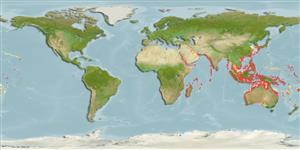Common names from other countries
Classification / Names / Names
Populärnamn | synonymer | Catalog of Fishes (gen., sp.) | ITIS | CoL | WoRMS
Environment: milieu / climate zone / depth range / distribution range
Ekologi
; djupintervall 0 - 50 m (Ref. 348). Tropical; 35°N - 37°S, 29°E - 154°W
Indo-West Pacific: from East and southeast Africa, including Madagascar, Mauritius Island, the Red Sea and the Persian Gulf, to New Caledonia; north to Japan and south to South Australia. Generally absent from oceanic islands of the central Indian Ocean and the tropical West Pacific, but sporadically found in Hawaii.
Length at first maturity / Size / Vikt / Age
Maturity: Lm ? range ? - ? cm Max length : 50.0 cm SHL hane/ej könsbestämd; (Ref. 348); common length : 40.0 cm SHL hane/ej könsbestämd; (Ref. 348); rapporterad maxålder: 18 år (Ref. 107096)
Species of minor economic importance, and collected for subsistence fisheries (Ref. 348). Maximum depth from Ref. 101118. Embedded in muddy sand and reef flats, in littoral and adjacent subtidal shallow waters to depths of about 10 m (Ref. 348). Also found buried in hard substratum and associated with seagrass beds (Ref. 101119). Planktonic larval stage probably short, hence a range restricted to the shores of continental areas and adjacent island (Ref. 348). Small benthic Pinna may likely depend on dissolved organic matter for nutrition (Ref. 107096).
Life cycle and mating behavior
Könsmognad | Reproduktion | Lek | Ägg | Fecundity | Larver
Planktonic larval stage (Ref. 348).
Poutiers, J.M. 1998. (Ref. 348)
IUCN Red List Status (Ref. 130435)
CITES status (Ref. 108899)
Not Evaluated
Not Evaluated
Human uses
Fiskeri: kommersiell
| FishSource | Sea Around Us
Verktyg
Internet-källor
Estimates based on models
Preferred temperature
(Ref.
115969): 18.7 - 29.1, mean 27.9 (based on 1460 cells).
Resiliens
Hög, lägsta populationsfördubblingstid mindre än 15 månader (K=0.88).
Prior r = 0.84, 95% CL = 0.56 - 1.27, Based on 1 data-limited stock assessment.
Vulnerability
Moderate vulnerability (40 of 100).
Price category
Unknown.
